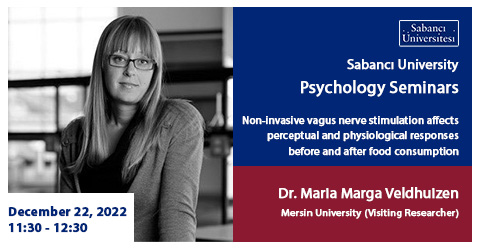Psychology Seminar: Maria Marga Veldhuizen (Mersin University)
Non-invasive vagus nerve stimulation affects perceptual and physiological responses before and after food consumption
Non-invasive vagus nerve stimulation (nVNS) improves otherwise untreatable depression and epilepsy. The vagus nerve plays an important role in transmitting signals from the gut to the brain. Such signals play a role in learning to like foods and are attenuated in eating disorders. With nVNS behavioral and neural responses to foods may be strategically adjusted. There is disagreement on the optimal location of nVNS in the ear for experimental and clinical studies. There are also no studies comparing nVNS in hungry and post-consumption states. We aimed to compare ear position(s) for nVNS and explore the effects of nVNS during hungry and post-consumption states on proxies for autonomic outflow (heart-rate variability) and efferent metabolism (gastric wave frequency and resting energy expenditure), as well as on perception and hedonics of the palatable drink and perception of internal and other states. Here we report results from a study with a within-subject design. Participants received nVNS in four different locations (cymba conchae, tragus, earlobe, or tragus AND cymba conchae) on separate days. In each session, participants were asked to consume a palatable chocolate flavored milk. Pre-drink consumption (in a hungry state) nVNS in cymba conchae decreases heart-rate variability (relative to sham) and ratings of how much participants want to consume the drink (relative to tragus AND cymba conchae and a trend relative to sham). Post-consumption heart-rate variability decreases in all locations, except cymba conchae. These results suggest that nVNS in the cymba conchae in a hungry state has a similar acute effect on vagal tone as food consumption: to decrease heart rate variability. This effect then negates the usual post-consumption effects of a decrease in heart rate variability as seen in the other nVNS locations. These observations suggest that nVNS in cymba conchae may act primarily on vagal afferent autonomic in a similar way as food consumption does.
FASS 2034
https://sabanciuniv.zoom.us/j/92824760566
